Last in its class: self-propelled mortars Karl
In the last years of the Weimar Republic, its leadership, fearing sanctions from the countries that won the First World War, tried to classify almost all their military projects. A smaller veil of secrecy covered only those programs that fit into the terms of the Versailles Peace Treaty. Powerful artillery until a certain time existed only in the form of projects on paper, access to which had a limited circle of persons. In 1933, the government in Germany changed, which led to significant changes in the economic, political and social spheres. Among other things, the new leadership of the country, headed by A. Hitler, didn’t become sensitive to the 1919 peace treaty of the year, or even openly ignore it. The formation of the Wehrmacht and the change in the course of development of the country led to the beginning of several serious projects, including in the field of large-caliber artillery.
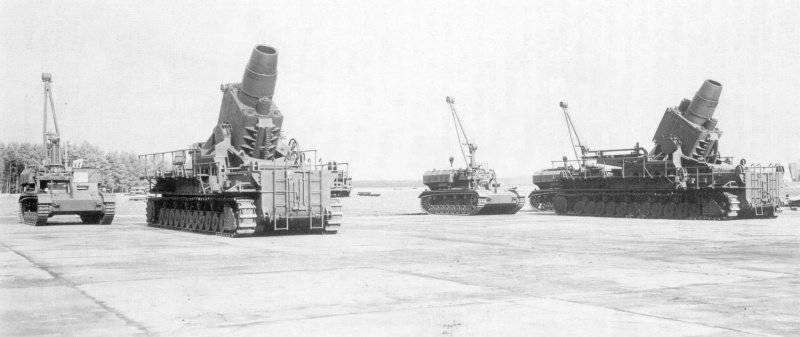
In 1934, the Army Armaments Directorate issued to the industry a task to develop a heavy artillery gun that could destroy or, at a minimum, destroy a concrete object with walls up to 900 millimeters thick in one shell. The task was not easy and several companies were attracted to his decision, among which was Rheinmetall Borsig. This enterprise was the first to develop a more or less realistic appearance of the new instrument. With an acceptable propellant charge and tolerable recoil, the hypothetical gun should look like this: a four-ton projectile of 600 mm caliber should be ejected from a relatively short barrel with a speed of no more than 100-110 meters per second. When mounted shooting 600-mm projectile could ensure the destruction of a given target at a distance of up to a kilometer. In 1935, the Wehrmacht leadership instructed Rheinmetall to continue work on the project and bring it to the state of a practically usable weapon. At this stage, the future self-propelled mortar was given the name Gerät 040 (“Installing 040”) and the unofficial nickname Karl. The latter was due to the participation in the project of General Karl Becker. An army representative supervised the project and submitted several original ideas. As a token of appreciation, the engineers at Rhinemetal began calling their brainchild after Becker.
Two years after the start of work, the project reached the prototype testing stage. A mortar of a millimeter 600 caliber, weighing 54,5 tons, was delivered to the landfill. During the development, the customer came to the conclusion that the firing range was insufficient. The four-ton projectile flew only a kilometer, and that was not enough. As a result of consultations and additional calculations, engineers and the military agreed on the possibility of halving the mass of ammunition. The two-ton projectile was already flying three kilometers. At the same time, this figure also did not suit the military. During the refinement of the artillery system, the barrel length was increased. In the later stages of the development of the mortar itself, this parameter was equal to 5108 millimeters. This led to an increase in the mass of the gun and increased the firing range by more than a third.
The firing characteristics of the Gerät 040 cannon caused mixed reactions from the military. On the one hand, the 600-mm two-ton projectile fully met the requirements of power. On the other hand, the firing range of just four kilometers was clearly not sufficient for most cases. A heavy-duty mortar could not have time to make a sufficient number of shots and fall under enemy fire. In addition, Germany did not have and did not anticipate the tractors, which could tow a new weapon, which further reduced the survivability of the battlefield and precluded the possibility of a relatively quick departure from the position. Based on these considerations, in 1937, the Karl project was continued. In the middle of July, the Rheinmetall-Borsig company was tasked to make a self-propelled gun carriage for the Gerät 040 gun. Given the weight of the mortar itself, the carriage-chassis had to be constructed from scratch, only using some work on other topics.
As a result of the design and assembly work in 1940, a gun with a ready-made tracked chassis was brought to the landfill. The basis of the self-propelled gun carriage was the Daimler-Benz DB507 XHUMX horsepower engine, located in front of it. Through hydromechanical transmission with three torque converters, torque was transmitted to the drive wheels. The running gear of the prototype consisted of tracks and eight road wheels on board with a torsion suspension. Serial chassis received eleven rollers on board. Due to the tremendous recoil force of the 750 gun, the original mechanism had to be used in the suspension. The inner ends of the suspension torsion bars were not firmly fixed. On the contrary, they were connected with movable levers. In preparation for firing, a special lowering mechanism, located in the rear part of the chassis, shifted the levers, due to which the machine lowered its bottom to the ground. At the end of the shooting, the operation was repeated in the opposite direction and the self-propelled mortar could start moving.
The gun itself at the time of installation on the chassis looked as follows. The 600 millimeter rifled barrel with a 8,5 length of calibers was made in one block with the breech and installed on the machine in the middle part of the chassis. The mechanics of the suspension of the gun made it possible to raise the barrel by an angle of up to 70 ° and rotate it in a horizontal plane within a sector four degrees wide. The huge return was compensated at once by two sets of recoil devices. The first system was attached directly to the cradle of the barrel and took the "first blow". The second, in turn, extinguished rollback machine mortars. Three large-caliber ammunition was developed for the Gerät 040. The lightweight concrete shell weighs 1700 kg (280 kg of explosive), heavy armor-piercing weighs 2170 kg (348 kg of explosive), and high-explosive - 1250 kg (460 kg explosive).
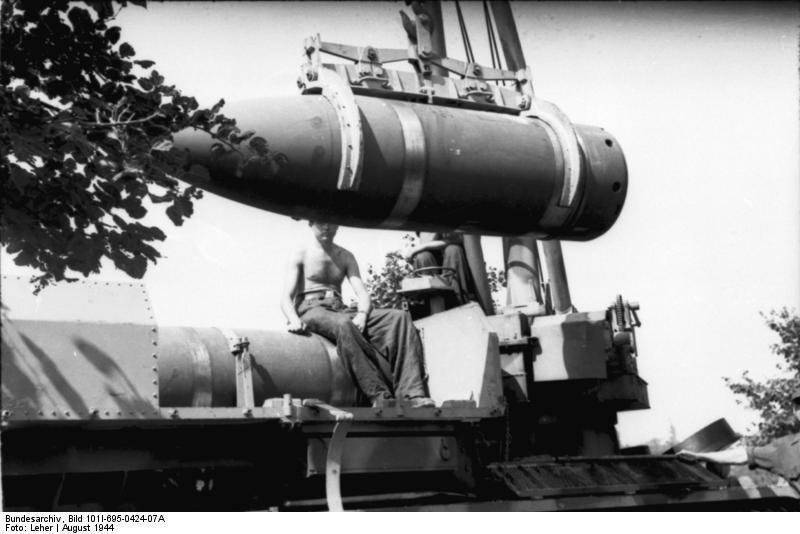
The finished self-propelled mortar weighed 97 tons, the engine power was only enough to move at low speed. Nevertheless, the combat potential of the gun looked promising, and its inadequate running characteristics simply closed their eyes. However, a relatively small firing range for such a caliber required an adequate level of protection. After receiving such a requirement, the chassis body received a new design of rolled armor plates with a thickness of 10 millimeters. Considerable chassis dimensions in combination with thicker and stronger metal led to an increase in the weight of the entire installation on 30 tons. In this form, self-propelled mortars Gerät 040 went into mass production.
Due to the complexity of the design and the lack of need for mass production, the series was limited to just six machines. Each of them got its own name. Starting in November 1940, the troops entered: Adam, Eva, Odin, Thor, Loki and Ziu. As you can see, the first two instances of self-propelled mortars were named after the biblical characters, and then the machines began to be designated by the names of the German-Scandinavian gods. It is worth noting that this “diversity” was later discontinued: “Adam” and “Eve”, as they say, for order, were renamed Baldur and Wotan, respectively. In addition, sometimes there are references to some seventh self-propelled gun named Fenrir, but there is no exact data on its existence. Probably, the first prototype was designated by this name. The last of the serial self-propelled Ziu mortars was transferred to the Wehrmacht in August 1941 of the year.
Serial machines had slightly better performance than the prototype. A heavy concrete shell received an initial speed of 220 meters per second and at distances of about four and a half kilometers punched up to 3,5 meters of concrete, or to 450 mm of armor steel. The explosion following the breakthrough guaranteed to destroy manpower and armaments inside the fortification, and also led to the collapse of structures. A lighter high-explosive projectile had a slightly higher initial velocity - 283 m / s, which gave it a range of 6700 meters.
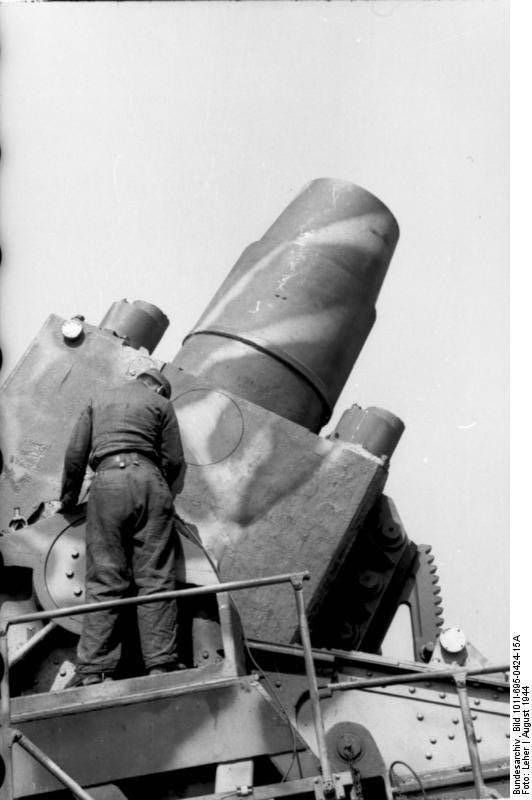
New self-propelled mortars were heavy and quite difficult to operate. Therefore, together with the actual "Karla" developed several special tools to ensure delivery to the battlefield and combat work. The maximum self-propelled speed of about 10 km / h did not allow her to make long marches on her own, and the fuel supply in liters of 1200 was only enough for four hours. Therefore, the main method of transportation made transportation by rail. Special hydraulic cranes were mounted on two five-axle railway platforms. Before loading, the self-propelled gun ran on the rails, where it was attached to the boom of the cranes and hung out between the platforms. For transportation by road, special trailers were made. On them, the self-propelled gun was loaded unassembled: the chassis, the chassis, the machine tool and the gun itself were mounted on separate trailers. By rail or road, the ACS was delivered to the battle area, after which, if necessary, it collected, refueled, and under its own power reached the firing position.
In addition to the self-propelled mortars on the position went loader ammunition. Each “Karlov” battery was given two cars each with a reserve of four shells and a crane. The basis for the transport-charging vehicle became the tank PzKpfw IV. Such machines were assembled total 13 pieces. Before firing, the self-propelled mortar went to the position, after which the person from the 16 calculated the orientation and direction to the target. With his turn, Gerät 040 turned in the right direction, the driver raised the lowering mechanism, and other calculation numbers made other preparations. On the entire preparation for the shooting took about ten minutes. After lowering the self-propelled gun to the ground, the calculation began to prepare the gun for a shot. With the help of a transport-loading machine crane, an 600-mm projectile was loaded onto a mortar tray, from where it was sent to the barrel chamber using a mechanical rammer. Further, the same procedure was carried out with the sleeve. The barrel was locked with a wedge gate. For lifting the trunk to the desired angle was used a mechanism with a manual drive. After raising the trunk carried out additional guidance in the horizontal plane. After loading and targeting, the calculation was removed to a safe distance and a shot was made. Then the calculation lowered the barrel to a horizontal position and again charged the mortar. To prepare for a new shot took at least ten to fifteen minutes.
Gerät 040 self-propelled mortars were transferred to the 628 and 833 battalions of special power artillery. At first, six self-propelled guns were distributed equally among the units. Soon, the car number 4 "One" was transferred to the 833-th division, and all six SAU collected in three batteries of two units. Apply "Carla" in the battle was originally intended during the capture of France, but this campaign was pretty short-lived and did not need special power artillery. The next appropriate target was found only in June of 41. Before the attack on the USSR, the first battery of the 833 Division was transferred to Army Group South, the second to Army Group Center. In the early days of the war, the Karl self-propelled guns fired on Soviet fortifications, including the Brest Fortress. A number of features of the use of mortars entailed the complaints of the gunners and their commanders. In addition, there were several problems with shooting. So, already 22 June in the trunks of "Odin" and "Torah" jammed shells. After a quick "repair" shooting continued. The total consumption of shells for a few days amounted to 31 thing. The first battery of the division participated in the siege of Sevastopol.
By the fall of 1941, the first four SAUs were sent to the factory for repairs and upgrades. In this case, "Adam" and "Eve" due to the workload of production stood idle for almost a year. Mortar "Thor", in turn, for several months has developed a barrel resource and it was proposed to use a new tool of a similar class in the repair. Modernization called Gerät 041 meant replacing the native rifled barrel of 600 caliber of millimeters with an 540-mm mortar. At about the same time that the fate of the “Torah” was being decided, the Rheinmetall Borsig factory completed the assembly of the fifth copy, called “Loki”. He immediately received a new barrel of a smaller caliber. The tests of the Gerät 041 cannon immediately showed greater effectiveness compared to the 600-mm mortar. The smaller diameter of the barrel and the mass of the projectile were compensated by a larger barrel length - 11,5 caliber, which increased the maximum firing range by one and a half times, up to ten kilometers.
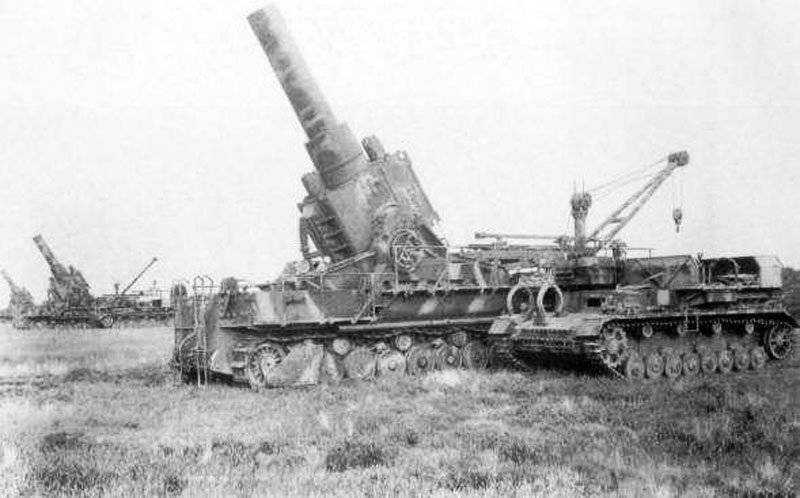
RЈR¶Rμ SЃ RґRІSѓRјSЏ RІR SЂRoR ° ° ° RЅS,R RјRo RІRѕRѕSЂSѓR¶RμRЅRoSЏ RЎRђRЈ In "RљR ° SЂR" B "RoSЃRїRѕR" SЊR RѕRІR · ° F "RoSЃSЊ RЅR RѕR ° ± RѕRoS RμRІSЂRѕRїRμR№SЃRєRoS ... ... C" SЂRѕRЅS,R ° С ... Р'торой РњРёСЂРѕРІРѕР№ РІРѕР№РЅС ‹. RћRЅRo SѓSЃRїRμR "Ryo RїRѕSѓS ‡ ° F SЃS,RІRѕRІR ° S,SЊ RїRѕS ‡ S,Ro RІRѕ RІSЃRμS ... RѕRїRμSЂR ° C RoSЏS † ... RіRґRμ S,SЂRμR RѕRІR ° ± P" SЃSЏ RѕR ± SЃS,SЂRμR "C ... RѕSЂRѕS € Рѕ Р · Р ° С ‰ РёС ‰ РµРЅРЅС ‹С ... С † ел ей. Рљ примеру, РІРѕ время Р'Р ° СЂС € Р ° РІСЃРєРѕРіРѕ РИосстР° РЅРёСЏ СЃР ° РјРѕС ... одиЂоовввЦЦЦЦЦЦЦжников Рё СЂР ° Р · СЂСѓС € С РёР »Р ° нескол СЊРєРѕ РєРІР ° ртР° Р »РѕРІ РіРѕСЂРѕРґР °. РҐР ° СЂР ° ктерной РѕСЃРѕР ± енноостью GerГ¤t 6 Р ± С ‹Р» Р ° СЃСЂР ° внительно РЅРёР · РєРѕР °СЅСЏСЏСЏСЏ RІРѕР · РІРѕР »СЏР» Р ° его РёСЃРїРѕР »СЊР · РѕРІР ° ть тол СЊРєРѕ РґР »СЏ стрел СЊР ± С ‹РІРѕ R ± РѕР» СЊРї Р ° Р °Р ° Р €Р € Р °Р € Р °Р € Р °Р ° Р €Р ° Рј СЖ РµР »СЏРј. РљР ° Рє реР· СѓР »СЊС‚Р ° С‚, РґР ° же С € есть РїРѕСЃС‚СЂРѕРµРЅРЅС ‹С ... СЃР ° РјРѕС ... еР· делР° РІРІРёРґСѓ отсутствия РїРѕРґС ... РѕРґСЏС ‰ РёС ... РјРёС € еней. RЎ RЅR ° C ° F ‡ P "RѕRј RЅR ° SЃS,SѓRїR" RμRЅRoSЏ SЃRѕSЋR RЅRoS · ‡ ... RμSЃRєRoS RІRѕR№SЃRє PI RќRѕSЂRјR RЅRґRoRo RєRѕRјR ° ° ° RЅRґRѕRІR RЅRoSЋ R'RμSЂRјR ° C ... S,R ° RїSЂRoS € P "RѕSЃSЊ РёСЃРїРѕР »СЊР · РѕРІР ° ть мортиры РґР »СЏ РѕР ± РѕСЂРѕРЅС‹. RSвРѕ, РІ РєРѕРЅРµС З РЅРѕРј СЃС З РµС‚Рµ, РїР »Р ° С З РµРІРЅРѕ СЃРєР ° Р · Р ° Р» РсСЃСЊ РЅР ° СЃСѓРґСЊР ± Рµ Р ± оеваР° С ... Уже Р »РµС‚РѕРј 040 РіРѕРґР ° aviation SЃRѕSЋR RЅRoRєRѕRІ SЃRμSЂSЊRμR · · RЅRѕ RїRѕRІSЂRμRґRoR "P ° RЎRђRЈ In" RўRѕSЂV "RѕR ± P" RѕRјRєRo RєRѕS,RѕSЂRѕR№ RЅRμRјRЅRѕRіRѕ RїRѕR · R¶Rμ SЃS,R ° F "Ryo RґRѕSЃS,RѕSЏRЅRoRμRј RЅR ° SЃS,SѓRїR ° SЋS ‰ Roes ... РІРѕР№СЃРє. Р 'РЅР ° С З Р ° Р »Рµ 45-РіРѕ СЃР ° РјРѕС ... РѕРґРєРё Wotan (Р ± С‹ РІС € Р ° СЏ В «Р • РІР ° В") Рё Loki Р ± С ‹Р» Рё РІР · РѕСЂРІР ° РЅС ‹СЌРєРёРїР ° жем Рё РІ СЂР ° Р · Р ± итом РІРёРґРµ достР° Р» РёСЃСЊ Р ° мерикР° РЅС † Р ° Рј. РЎСѓРґСЊР ± Р ° В “РћРґРёРЅР ° Р ° В” РѕРєР ° Р · Р ° Р »Р ° СЃСЊ РїРѕС ... ожей -“ РёР · -Р · Р ° невоР· можносвЍСРёРЌСРёРЌСРёРЌСРёРЌСРёРЌСРёРЌСРёРЌСРёРёРЌРёРЌРёРЌР ° С РµРµ РІР · РѕСЂРІР ° Р »Рё.
With the two remaining instances (Adam / Baldur and Ziu) a rather remarkable happened story. The fact is that the wreckage of one of the cars was never found. But in April, the 45 th Red Army soldiers captured an ACS with a tail number VI. Later, on the basis of German documents, it was decided that it was “Tsiu”. This self-propelled gun became an exhibit tank museum in Kubinka. During the restoration, which took place several decades after Ziu was included in the museum's collection, it was decided to clean off the old paint and paint the ACS in historically correct colors. After removing the next layer of paint on the artillery of the "Carl" the letters Adam appeared. There is still no exact information why there are two designations on the same self-propelled gun, and where the lost sixth car went.
Heavy self-propelled mortars Gerät 040 / 041 or Karl were the last representative of this class of military equipment. The greater complexity of operation, together with insufficient indicators of range and accuracy as a result, put an end to mortars. After World War II, the functions of artillery weapons intended for firing on a hinged trajectory with a large elevation were assigned to large-caliber mortars, and then to ballistic missiles.
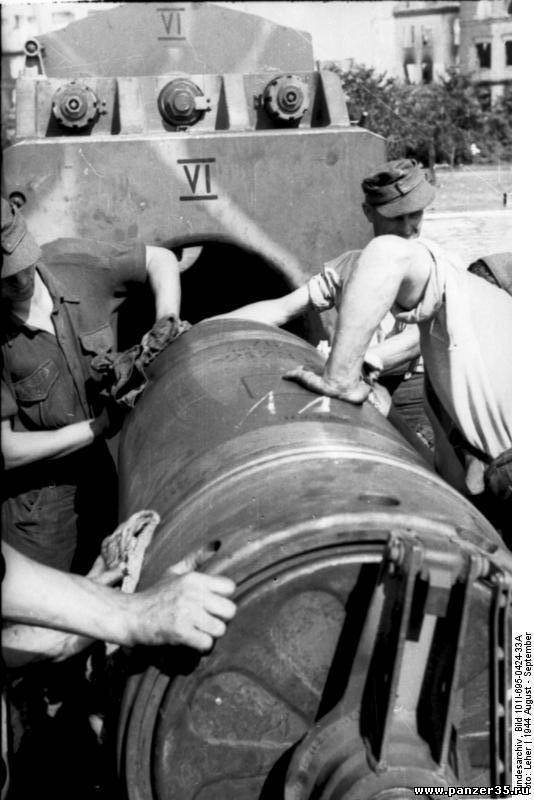
On the materials of the sites:
http://vadimvswar.narod.ru/
http://one35th.com/
http://wotanks.com/
http://ww2incolor.com/
http://rkka1941.blogspot.com/
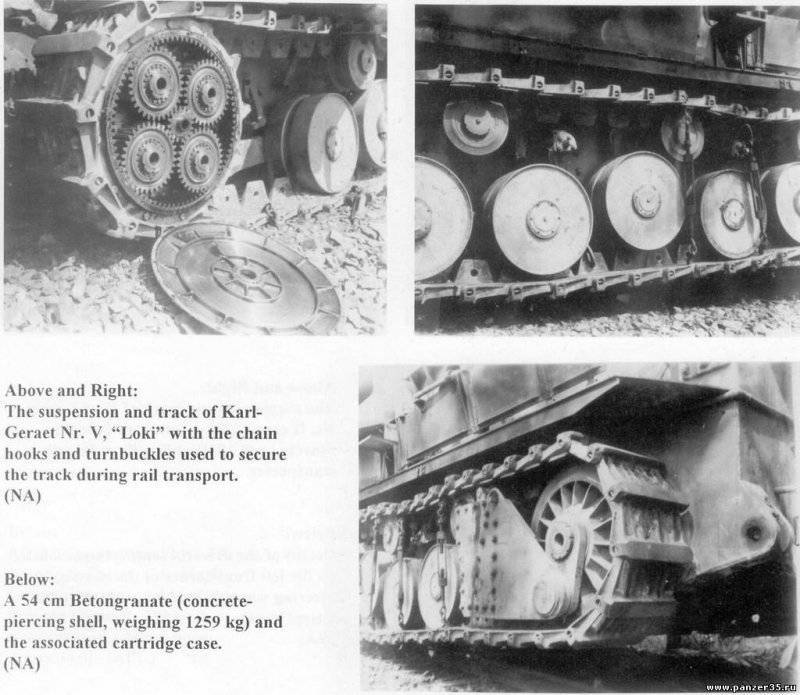
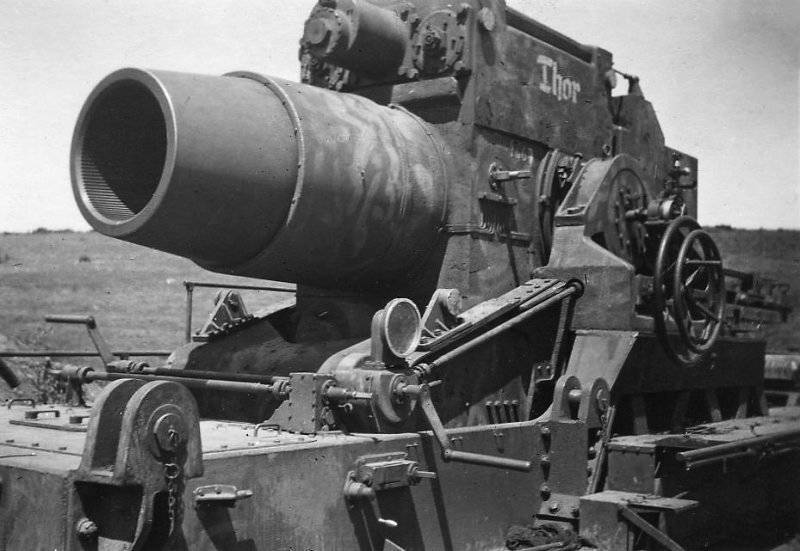
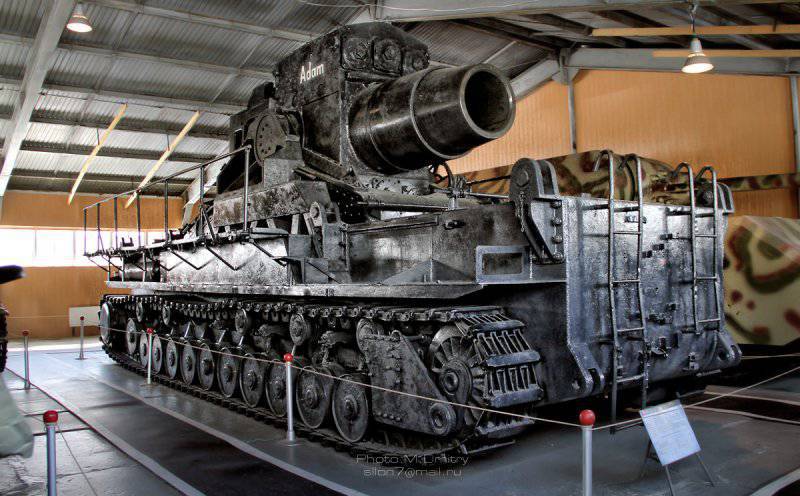
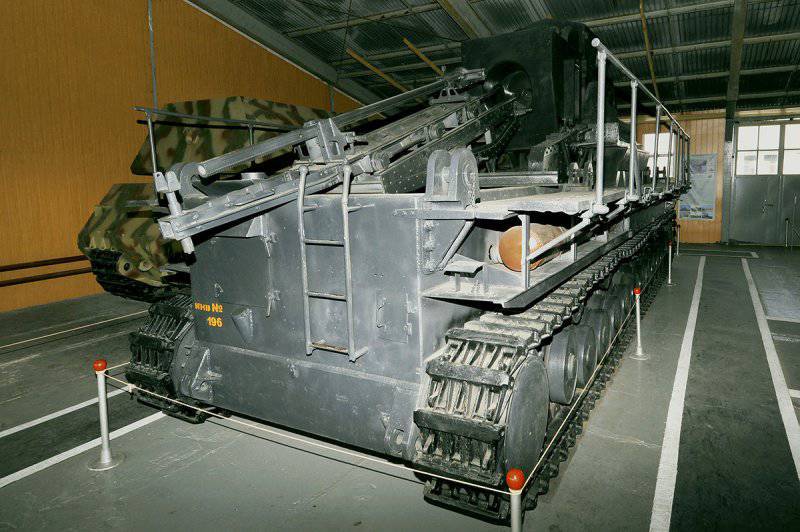
Information